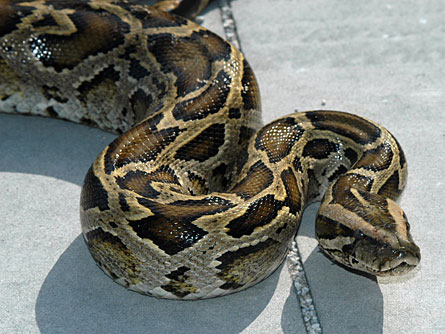Giant snakes invading North America
A new government study suggests the United States may see pythons in Pennsylvania by 2100
 |
|
This cold-tolerant Burmese python, captured in Florida, could possibly survive along the U.S. coasts as far north as Oregon and Delaware.
|
| Roy Wood, NPS/USGS |
There may be a strange, slithering invasion coming from the South. Big snakes like anacondas, boa constrictors and pythons now live in the wilds of southern Florida. Although not originally native to the United States, some of them are now being born there. Most were people’s pets (or the offspring of pets) that got too big, leading the owners to release them into the wild. So far, the snakes have stayed put. But there’s nothing stopping them from moving farther north.
According to a new study by government scientists, some species of large snakes could live comfortably in a large part of the United States—eventually sharing space with 120 million Americans. If the snakes ever start to migrate northward, they could find happy homes as far north as the coasts of Delaware or Oregon. And as North America heats up because of climate change, the scientists say, in 100 years the snakes could become common species in states like Washington, Colorado, Illinois, Indiana, Ohio, West Virginia, Pennsylvania, New Jersey and New York.
The report came from Gordon Rodda and Robert Reed at the U.S. Geological Survey, a government agency that studies the studies natural resources—and natural hazards. Rodda and Reed are both scientists and snake lovers. “We can testify to these snakes’ attraction personally,” the scientists say, “as we both have kept pet giant constrictors. We can attest to these snakes’ beauty, companionability and educational value.”
Rodda and Reed compared the climates of the snakes’ native habitats, where they occur naturally, to the climate of parts of the United States. (The climate of an area describes the average weather—including temperature, humidity, wind speed and rainfall.) Their 300-page report showed that the climate of much of the southern United States was a good match for the native habitat of some species of large snakes. These giant snakes could pose a big ecological problem for coastal states in particular.
Most of these snakes can grow to be 6 meters, or about 20 feet, long. (The boa constrictor, which is small by comparison, grows to be about 4 meters long.)
The Burmese python is one of the most difficult to get rid of. This giant snake can live in either tropical areas or places with cooler weather—and in both wet and dry places. In the United States, Burmese pythons have no natural predators (animals that eat the python and keep its numbers down), so they’re free to grow without watching their backs. These snakes have a ferocious appetite, too. They’ve been known to eat leopards, alligators, porcupines, antelope and jackals.
In 2000, the National Park Service captured and removed two Burmese pythons. The next year, they removed three more. But the numbers have grown fast—this year, they’ve already removed 270. Given this quick increase, removing these snakes probably doesn’t help solve the problem. The USGS scientists estimate there may already be tens of thousands Burmese pythons slithering around southern Florida.
The scientists aren’t sure how to get rid of the snakes. The government could ban keeping these snakes as pets—but that might not make much difference, since there are already so many in the United States. With enough time and money, snake-hunters could try to remove them all—but who wants to go chasing a 20-foot snake?
Or perhaps giant snakes will be the next fad in food—anyone want an “Anaconda burger”?
POWER WORDS (adapted from the Yahoo! Kids Dictionary and USGS.gov)
climate The weather conditions, including temperature, precipitation, and wind, that characteristically prevail in a particular region.
U.S. Geological Survey A science organization that focuses on biology, geography, geology and water, dedicated to the study of the landscape, natural resources, and the natural hazards that threaten us.
anaconda Either of two nonvenomous, semiaquatic snakesof tropical South America that kill their prey by suffocating it in their coils. E. murinus, the giant anaconda, can attain lengths from 5 to 9 meters (16.4 to 29.5 feet).
boa constrictor A large boa (Boa constrictor) of tropical America that has brown markings and kills its prey by constriction.
python Any of various nonvenomous snakes of the family Pythonidae, found chiefly in Asia, Africa, and Australia, that coil around and suffocate their prey. Pythons often attain lengths of 6 meters (20 feet) or more.
habitat The area or environment where an organism or ecological community normally lives or occurs. The place where a person or thing is most likely to be found.







